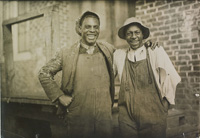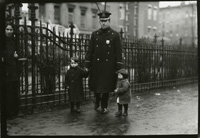Speakers, Advisors, Role Models
A number of photographers were involved with the Photo League from its founding in 1936. Although they did not all become members, they played essential roles by serving on the Advisory Board (which included Berenice Abbott, Margaret Bourke-White, and Robert Disraeli) or as lecturers in seminars and symposia. All of them provided inspiration through their work, whether it was socially oriented, as in the case of Lewis Hine and Dorothea Lange, or directed toward the “natural scene,” as with Ansel Adams and Edward Weston. Beaumont Newhall, the founding director of the photography department at the Museum of Modern Art, was a longtime supporter of the League, the work of which led him to formulate his ideas about documentary photography; in the first version of his now-classic history, Photography 1839–1937, these ideas existed in embryo in his section on “press photography”:
[F]requently a photograph is made which transcends the ephemeral and becomes a great document. The essence of some situation common to human experience is driven home with poignancy and truth. These pictures are worth more than a few seconds’ scanning; we may no longer feel any interest in the incidents they report, but we cannot afford to waste dynamic interpretations of the living world.
Berenice Abbott
(born 1898, Springfield, Ohio; died 1991)
Post Office, Robinson, Maine, ca. 1958
Huts and unemployed [West Houston and Mercer Streets], Changing New York, 1935
Greyhound Bus Terminal [33rd and 34th Streets between Seventh and Eighth Avenues], Changing New York, 1935
“Wait for the subject to become itself…. Unstopped motion does not necessarily detract from a picture. The most useful gift a photographer can have is a sense of light and lighting values.”
—Berenice Abbott, “Abbott Criticizes Prints,” Photo Notes, August 1946
Ansel Adams
(born 1902, San Francisco, California; died 1984)
Bridal Veil Falls, 1940s
Trailside, near Juneau, Alaska, 1948
Shirley Carter Burden Collection
Alfred Stieglitz, An American Place, New York, 1938, printed 1948
Shirley Carter Burden Collection
“We have been accused out West of doing too many mountains, rocks, and junipers. I for one have done most of my work in the natural scene. The choice of subject matter is somewhat determined by environment. Harlem does not exist in Yosemite Valley.”
—“Ansel Adams at the Photo League,” Photo Notes, March 1948
Margaret Bourke-White
(born 1904, the Bronx, New York; died 1971)
This, in its way, is a typical Midland home—that of Mayor Rollin H. Bunch, who, with his wife, is shown in his dining room, Muncie, IN
Published in LIFE magazine, May 10, 1937
Gift of John C. Manthorp
Lower in social standing than “The Pig” is Middletown’s “The New Deal,” pool room and bar on South Walnut Street
Published in LIFE magazine, May 10, 1937
Gift of John C. Manthorp
Drying coffee, 1950s
“Show how the people live.”
—“Margaret Bourke-White Speaks to Large Audience,” Photo Notes, June 1939
Robert Disraeli
(born 1905, Cologne, Germany; died 1988)
Window washer, ca. 1940
Miriam and Ira D. Wallach Fund
“Here is a photographer whose work represents in a well developed form the type of photography in which the Photo League is most interested. Members who heard Robert Disraeli at the Photo League over a year ago still remember that talk. Eighteen years of professional experience and a vital awareness of the world about him give weight to every word that he has to say on the subject.”
—“The Passing Scene,” Photo Notes, May 1938
Lewis Hine
(born 1874, Oshkosh, Wisconsin; died 1940)
A frequent contributor of photographs illustrating social and labor conditions to books, magazines, and governmental agencies, Hine also documented the construction of the Empire State Building (1930–31) and headed the National Research Project of the Works Project Administration (1936–37).
In spite of this, he was relatively unknown in 1939, when he was the subject of a retrospective exhibition at the Riverside Museum and also began frequenting the Photo League. Hine quickly became the primary role model for League members interested in socially engaged photography.
He died in 1940, the same year he officially joined the League, to which his son Corydon donated his estate. A “Hine Committee” was formed to orga-nize and print from his negatives, which became an important funding source for the League. The photographs exhibited here are vintage contact prints, originally obtained by The New York Public Library’s Picture Collection from Hine’s studio in Hastings-on-Hudson, New York.
Old time craftsman printer using the old type of foot press, New York City, ca. 1905
Ellis Island, 1905

[Two mill workers], ca. 1905
Rendezvous of the gang down by the sugar works on the Hudson, Yonkers, New York, ca. 1907
Stevedores on coastwise steamer unloading at Charleston, S.C., ca. 1909
Slavic coal miner in Pittsburgh district, 1910
Sweat shop, ca. 1915

Lost and found, New York City, ca. 1915
Candy sorter in an old Huyler factory, ca. 1915
Jewish grandmother, Ellis Island, ca. 1926
Empire State Building construction, 1931
Close up of hands of winder operator, National Research Project, ca. 1937
“Mr. Hine came to photography with the purpose of making sociological records. He was trained as a sociologist. Instinctively he grasped the real meaning of the work he was called upon to do. He recognized the dignity and true meaning of the workingman and woman and reflected this in his work.”
—Sol Libsohn, “A Statement on Exhibition Policy,” Photo Notes, December 1939
Dorothea Lange
(born Dorothea Margaretta Nutzhorn, 1895, Hoboken, New Jersey; died 1965)
Resettled child just arrived at government project in New Mexico, Farm Security Administration, 1936
The O’Hallorans, County Clare, Ireland, 1954
Secluded woman, Pakistan, 1958
Egypt, 1963
“We must break down the barriers between [photographers] and sociologists, economists
and social workers.”
—Dorothea Lange, “Lange Visits Photo League,” Photo Notes, September 1939
Beaumont Newhall
(born 1908, Lynn, Massachusetts; died 1993)
Edward Weston’s kitchen, n.d.
Shirley Carter Burden Collection
Ralph Steiner
(born 1899, Cleveland, Ohio; died 1986)
[Merry Christmas window display], 1922, printed 1981
Gift of Brenda Edelson
“Ralph Steiner, well-known documentary still and motion picture photographer and picture editor of PM’s Weekly, was the feature speaker at the August 9 general membership meeting at the League. Mr. Steiner’s subject was ‘Art and Documentary Photography.’ The trouble with most photographs, Mr. Steiner said, is that they tell their stories too weakly.”
—“Ralph Steiner at the League,” Photo Notes, September 1940
Edward Weston
(born 1886, Highland Park, Illinois; died 1958)
H.K. Landis, Landis Valley, Pennsylvania, 1941
Shirley Carter Burden Collection
“Weston’s nudes have occasionally caused him exhibition difficulties.… Weston also ruffled the feathers of certain friends with pictures of a different sort. Throughout the war period he was kept close to home by gasoline rationing and by his duties as a volunteer civilian air and sea watcher (up in a cold shack on the coast, at night). Accordingly, he turned his lens on his own back yard—his beautiful cats, the trees and rocks around his house, the faces and bodies of his family and friends.”
—Louis Clyde Stoumen, “Week-End with Weston,” Photo Notes, June 1948
Next Section